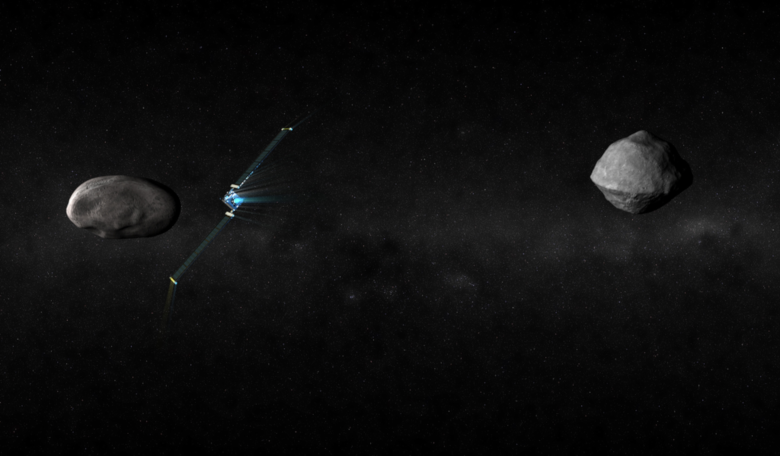Early Wednesday morning, weather permitting, NASA will launch DART, the world’s first mission to intentionally crash into an asteroid to test whether the impact is enough to shift its orbit; a scenario that could be used for real should humanity ever find a sizeable space rock on a collision path with Earth.
Blasting off on board a SpaceX Falcon 9 rocket from Vandenberg Space Force Base, California at 1:20 am ET (06:20 GMT) on 24 November, DART, which stands for Double Asteroid Redirection Test, will head on a 10 month journey to Dimorphos, a small moonlet asteroid that orbits a larger companion asteroid called Didymos.
Didymos – which means "twin" in Greek – was discovered on 11 April, 1996, by researcher Joseph Montani of Spacewatch at Kitt Peak National Observatory in Tucson, Arizona.
Approximately 780 metres-wide, Didymos is classified as a member of the Amor group of asteroids, named after asteroid 1221 Amor. It has a rapid spin – it rotates about once every 2.26 hours – and although its surface cannot be seen in great detail from Earth, scientists think it might be like similarly shaped asteroids that have already been visited by spacecraft, such as Bennu and Ryugu.
A few years after its discovery, scientists confirmed that Didymos had a moon that orbited about one kilometre (0.62 miles) away. Originally dubbed Didymos B and/or Didymoon and subsequently changed to Dimorphos, the moonlet was found to be about 160 metres (525 feet) in diameter.
The duo orbit the Sun in around 2.11 years and get as close as 0.048 AU from Earth (one astronomical unit, AU, is the distance from the Sun to Earth). At its farthest, when Didymos is on the opposite side of the Sun from Earth, a bit beyond the orbit of Mars, the pair can be as far away as 3 AU.
Because the two asteroids are not a threat to Earth, but they do pass close to our planet, they were chosen as targets to test whether a spacecraft can autonomously navigate to a chosen asteroid, bump into it – in Dimorphos’ case, DART will hit the moonlet at speeds of approximately 6.6 kilometres per second – and knock it off course. Or at least that is what the team behind the mission are hoping.
“DART will be the first demonstration of the ‘kinetic impactor’ technique in which a spacecraft deliberately collides with a known asteroid at high speed to change the asteroid’s motion in space,” said Lindley Johnson, NASA’s Planetary Defense Officer earlier this month. “This technique is thought to be the most technologically mature approach for mitigating a potentially hazardous asteroid, and it will help planetary defense experts refine asteroid kinetic impactor computer models, giving insight into how we could deflect potentially dangerous near-Earth objects in the future.”
Researchers will get to see the asteroid system up close using images returned from DART’s only onboard instrument, called DRACO (Didymos Reconnaissance and Asteroid Camera for Optical navigation). DRACO is a high-resolution imager and will help DART navigate to the Didymos system.
In its final minutes, DRACO will also stream images back to Earth at the rate of one per second, enabling the DART team to measure the moonlet’s size and shape to determine the impact site.
Earth-based telescopes will also be on hand to measure the effects of the impact on the asteroid system.
Joining DART on its mission will be a small spacecraft known as the LICIACube (Light Italian CubeSat for Imaging of Asteroids).
Contributed by the Italian Space Agency (ASI), the shoebox-sized passenger will separate from DART several days before DART’s impact with the moonlet. LICIACube will capture images of the impact and material kicked up from the moonlet and will attempt to photograph the crater caused by the impact through the haze of any ejecta that may get in the way. The cube will also image the backside of the moonlet, which DRACO will never get a chance to see.
Loaded with with roughly 50 kilograms (110 pounds ) of hydrazine propellant for spacecraft manoeuvres and attitude control and around 60 kilograms (130 pounds) of xenon for its NEXT-C ion engine, DART has been prepped for flight since it arrived at VSFB in early October.
Engineers have already “mated” the spacecraft to the adapter that stacks on top of the SpaceX Falcon 9 rocket and a day before launch, the rocket will roll out of the hangar and onto the launch pad at Space Launch Complex 4 East (SLC-4E).
“I’m both amazed and grateful that DART has gone from a twinkle in the eye to a spacecraft in final preparation for launch within 11 years,” said Andy Cheng, DART investigation team lead at APL and the one who came up with the idea of DART. “What made it possible was a great team that overcame all the challenges of building a spacecraft to do something never done before.”
According to NASA, weather is 90 percent go for the DART launch on Wednesday, “with only a 10 percent of violation (POV) for winds with no other area of concern”.
If circumstances change and weather or other issues prevent a launch, the team will have an additional opportunity to launch the next day. If necessary, subsequent launch attempts can take place through February 2022.
Dart is being followed up with ESA’s Hera mission that will also head to Didymos to conduct post-impact investigations. Hera will arrive at the asteroid system in 2026 and measure for example, the precise mass of Dimorphos, its makeup and its internal structure, as well as the size and shape of the crater left by DART.











